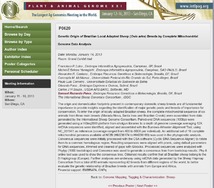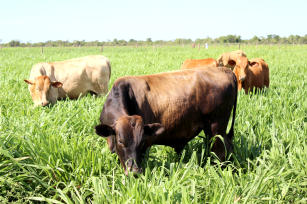Genetic origin of Brazilian local adapted sheep (Ovis aries) breeds by complete mitochondrial genome data analysis.
Genetic origin of Brazilian local adapted sheep (Ovis aries) breeds by complete mitochondrial genome data analysis.
Autoria: LOBO, F. P.; YAMAGISHI, M. E. B.; CAETANO, A. R.; MCMANUS, C. M.; CARNEIRO, P. L.; FACO, O.; SOUZA, C. J. H.; PAIVA, S. R.
Resumo: The origin and domestication footprints present in contemporary domestic sheep breeds are of fundamental importance to provide insights regarding the identification of major genetic pools and breeds of importance for conservation. To infer the origin of locally adapted Brazilian sheep, the complete mitochondrial sequence of six animals from three main breeds (Morada Nova, Santa Ines and Brazilian Creole) were assembled from data generated by the International Sheep Genome Consortium. Paired-end DNA sequences (100bp) were generated using a HiSeq2000 platform from shotgun libraries to a depth of genome coverage averaging 12X. mtDNA sequences were identified, aligned and assembled with the Burrows-Wheeler Alignment Tool, using NC_001941 as reference (coverage ranged from 400 to 800X per individual). An additional set of 16 complete mitochondrial genomes available at NCBI (HM236174 to HM236189) was used in the phylogenetic analysis. Consensus sequences were initially processed with the CSA software (Cyclic DNA Sequence Aligner) to rotate them to a common homologous region. Resulting sequences were aligned with prank, using default parameters for DNA sequences, trimmed and cleaned of gaps with Gblocks. Processed sequences were analyzed with Phylyp (1000 bootstraps) and Consence was used to generate a consensus tree from bootstrap results. Phy-fi online tool was used to draw the consensus tree. Obtained results confirm that all Brazilian sheep belong to the B Haplogroup (Europe). Further analyses are underway using mtDNA data generated by the Sheep Hapmap Consortium from a total of 80 animals representing 42 breeds from different regions of the world, to better evaluate the genetic relationship of Brazilian breeds with animals from Europe and Africa.
Ano de publicação: 2013
Tipo de publicação: Resumo em anais e proceedings
Unidade: Embrapa Agricultura Digital
Palavras-chave: Gene mapping, Genomes, Genomics, Genômica, Mapeamento de genoma, Mitochondrial DNA, Mitochondrial genetics, Ovelha, Ovino, Recurso genético, Sequência de DNA, Sheep
Conteúdo relacionado
Observações
1 - Por padrão são exibidas publicações dos últimos 20 anos. Para encontrar publicações mais antigas, configure o filtro ano de publicação, colocando o ano a partir do qual você deseja encontrar publicações. O filtro está na coluna da esquerda na busca acima.
2 - Para ler algumas publicações da Embrapa (apenas as que estão em formato ePub), é necessário ter, no celular ou computador, um desses softwares gratuitos. Sistemas Android: Google Play Livros; IOS: iBooks; Windows e Linux: software Calibre.
Acesse outras publicações
Acesse a Base de Dados da Pesquisa Agropecuária (BDPA) para consultar o acervo completo das bibliotecas da Embrapa.


